|
Preserving Community Character
by preserving character-defining features
By Allen A. Hazard & Janet O'Dea
Despite an economic downturn, there appears to be little relief from inappropriate remodeling, teardowns, or the building of McMansions within San Diego County's historic neighborhoods. In 2002, the National Trust for Historic Preservation listed "Teardowns in Historic Neighborhoods" among their 11 Most Endangered sites. As recently as 2005 and again in 2008 SOHO listed "Historic Neighborhoods" on their "Most Endangered" list. Clearly, this is a crisis with both aesthetic and financial consequences that remains to be resolved.
As we explore our historic communities, we notice far too many historically inaccurate changes in the architectural features that define historic homes: removal of original wood windows, replacement of clay roof tiles, removal of original doors, replacement of wood garage doors with cheap, mass-produced doors, and the gutting of interiors of historic buildings. Some call it updating. Frank Lloyd Wright called it remuddled. We call it just plain uninformed.
According to the National Park Service, a character-defining feature is "a prominent or distinctive aspect, quality, or characteristic of a historic property that contributes significantly to its physical character." In other words, character-defining features are those things that make a property special and make it worthy of inclusion within a historic district.
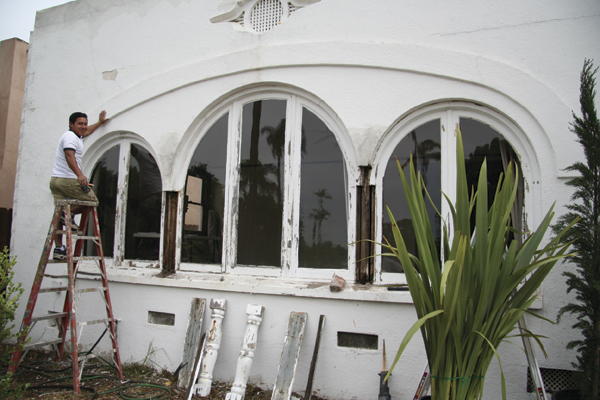
Current restoration of a 1921 Morris Irvin Spanish Revival home, workmen are restoring decorative pilasters.
Our historic homes give our communities and our towns their historic scale and character. These homes embody the distinctive patterns of our past and tell a story. As such, they are more valuable when they retain their historic character.
Remodeling your old home can result in critical aesthetic and financial blunders whereas retaining original features retains property values. Whether your home is a short-term or long-term investment, preserving your home's street appearance helps preserve that investment.
What they don't tell you is that Less is often More. We certainly understand how the updating craze has gone terribly wrong. The powerful marketing influences of home stores, glossy magazines and television programs like "Flip that House" and "Extreme Home Makeover" showcase remodeling as a fast improvement often claim that there is a return on investment especially if one is about to sell. These solutions they are offering don't apply to historic buildings because retaining the features and distinctions of your house is actually what gives its value. Likewise protecting and maintaining the historic character of the building is not on the minds of the salesperson as he/she is they are pitching the energy savings of new vinyl windows.
You might also keep in mind that if you ever want your home to become eligible for historic designation or to make this important benefit available for a future owner, then it is essential to retain your home's character-defining features.
So what features are worthy of restoration and maintenance? In addition to overall design, shape, and scale of the building, here are some, but not all, of the important character-defining elements that distinguish one style of home from another, and as such are worth saving.
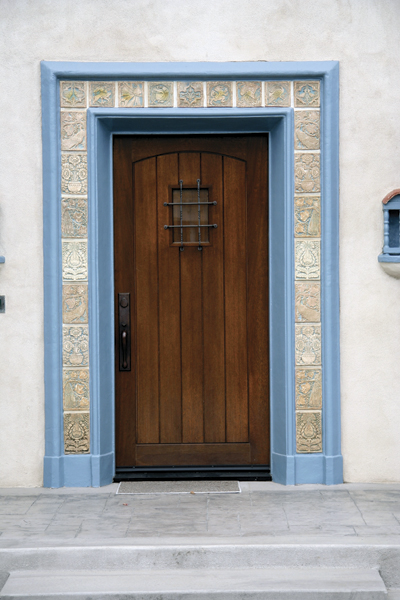
Rare exterior use of Batchelder tile as pointed out during a recent SOHO trolley tile tour by Joseph Taylor of the Tile Heritage Foundation.
|
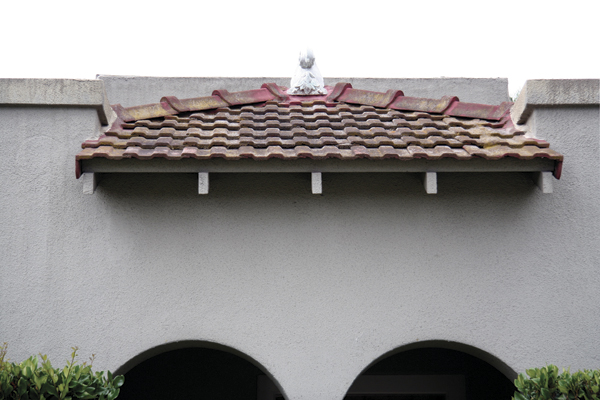
Roman tiles on a 1920 Morris Irvin Mission Revival home and exposed rafter tails.
|
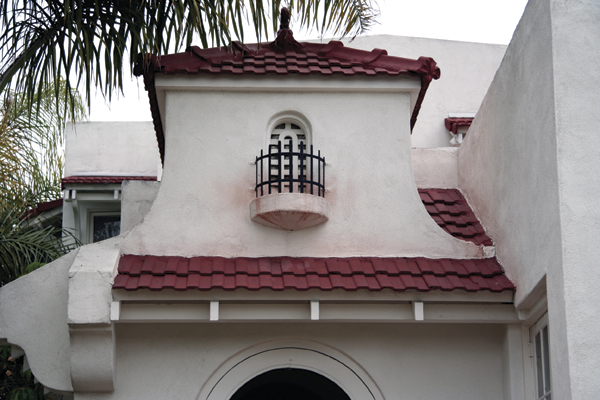
Original Roman tiles on another Morris Irvin Mission Revival home with diminutive bell tower and decorative balcony. A sensitive addition lies toward the back of this 1921 home.
|
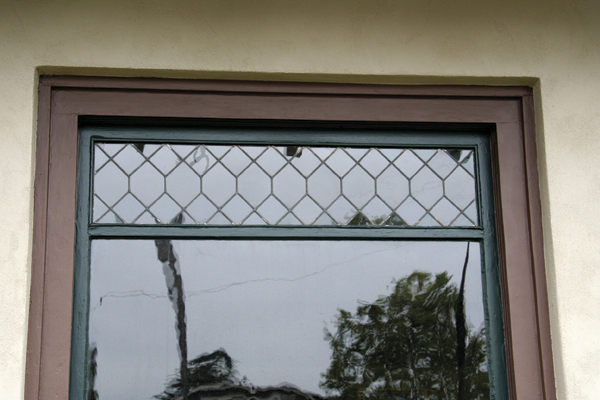
Original 1920 California Craftsman window with English-influenced leaded glass accented with a Sherman Williams historic sash paint color.
|
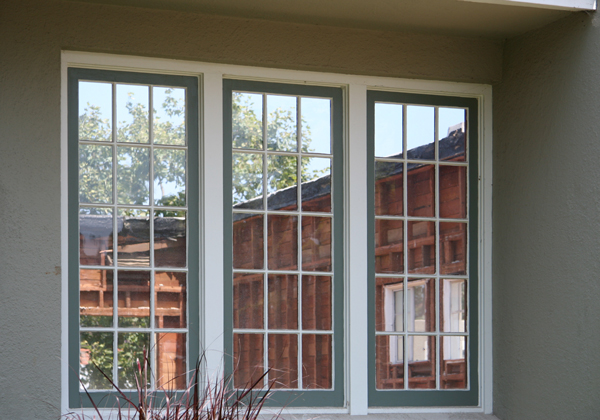
McMansion in the making; unfortunately, historic designation did not prevent the
owners from completely gutting this Morris Irvin Spanish Revival; tragically only three original walls stand.
|
Key Exterior Architectural Features
Doors
The front door greets visitors and was often designed to create an impression. Craftsman doors ranged from simple to complex in design.
A cautionary tale: we know of a homeowner whose front door veneer of her 1918 house had cracked. Instead of repairing it, which would have cost a few hundred dollars, she purchased a brand new Craftsman-style door for about $6,000. Her home's original door was thicker, heavier, and made of old-growth wood. In short, it was made better. It just needed a little TLC, not to be tossed into the landfill! Original doors are important to keep, and more often than not, a craftsman can repair them.
Roofs
The replacement of original clay tiles on Mission and Spanish Revival homes has become something of an epidemic. The new tiles are obvious even to the untrained eye. Clay tile may break but it never wears out so there is rarely a good reason to replace tile roofs. At most they may require spot replacement where they have become damaged.
Character-defining details of historic tiles include the type of clay tile used, shape, and the glaze. These old tiles were often shaped and glazed by hand and are never uniform in color. Additionally, old tiles gain a patina garnered only by the passage of time.
In contrast, what is used today is most often the s-shape, a tell-tale sign of a modern roof. Modern replacement tiles also have their glazes sprayed on. Their lack of color range detracts from the historic appearance of an older home.
Windows
Beware the window salesperson. One of the biggest mistakes homeowners make is ripping out original wood windows. The old-growth wood used to build these windows cannot be replaced, but more often than not, these windows can be repaired. This dense old-growth wood has a life expectancy of at least 200 years. New wood windows will last 50 years, vinyl about 10 to 15 years.
Removing the original wood windows devalues your home, and in a climate like San Diego's, the energy argument isn't justified. One reason the home loses so much value is that in order to replace a window, the window frame must also be torn out and replaced, thus begins the destruction of your home's architectural integrity.
Siding
Original wood siding should always be retained. Properly maintained, it will last many lifetimes. Repair of wood siding should take into account the width and profile of the siding. The use of synthetic siding should always be avoided.
Porches
Important to individual properties, porches are also important to the streetscape. It is essential to retain original materials and designs in elements like rails, spindles, posts, floors, and roofs. Porches should not be removed or enclosed. Roof size and shape should not be changed. Replacing items with artificial or inappropriate materials can ruin one of the greatest assets of a home and blight the streetscape.
In addition to all of the elements already mentioned as worthy of restoration and maintenance, consideration should also be given to decorative elements, appropriate color schemes, setbacks, lighting, walkways, fences, and significant landscaping features.
But perhaps the best advice for taking on a restoration project is to follow the old adage: Do nothing for one year. You have likely heard the suggestion that you live in your home for at least one year before making any changes. Living in the home can become a resource in and of itself. Most mistakes are apt to be made in this first year.
Allow your home some time to show you how it was originally designed to work through the four seasons. Those who heed this essential advice will save themselves tens of thousands of dollars and inevitably find that what was first thought of as undesirable becomes what is most loved about the home.
When you finally do undertake work on your home, look for experienced old-home experts. They are worth their weight in gold. Ask around and follow up on references, especially from those who have restored their homes. If a contractor tries to insist that you have to remove historic materials, don't hire him or her. There are plenty of contractors and handymen in town who don't understand what the historic features of your home are, and they should not be working on it. It takes some extra diligence to take care of your historic house. But the home you preserve will not only be worth a lot more, it will continue to tell a story for future generations.
All photos by Allen Hazard. Allen and Janet are frequent contributors to SOHO's publication. They are founding members of Mission Hills Heritage, and have a business devoted to early 20th century decorative arts.
|
MORE FROM THIS ISSUE
From the Editor
2008 Most Endangered List of Historic Resources
Character Matters
Smart Growth - or is it?
The Impact of Historic Districts
Washington Didn't Sleep Here
How to Research Your House
Preserving Community Character
Behind the Tuscany Craze
2008 People In Preservation Award Winners
Preservation Community
Reflections
Annual Financial Report
Book Review - Working Windows
Sherlock Homes
Speakers Bureau Forming
Lost San Diego
Strength in Numbers
Advertisements
DOWNLOAD full magazine as pdf (16mb)
|









